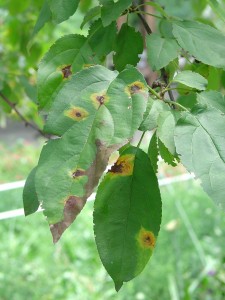Warm weather in early spring means scab, cedar apple rust and powdery mildew diseases are upon the new leaves as they start to emerge. Preventative spraying for leaf diseases will result in management of additional fungi diseases through the growing season.
Fungicides are protectants and not cure-alls. A light rain shower (as little as ¼ inch of precipitation) will wash off the “water soluble” spray and it must be re-applied as soon as possible. Timely spraying helps to break the disease cycle.
Beginning in late March, across most areas of the Southern Appalachian region (USDA zones 6 and 7), spray only fungicides in early spring as not to injure our fragile bee populations which are pollinating flowers. Most insect pest problems on fruit trees do not start until after petal fall.
Cedar-apple rust and powdery mildew are primarily threats in the wet cool spring period. Cedar apple rust infections decline by late May. Keep in mind that some apple varieties are more susceptible than others to disease pressures.
Begin spraying when flower buds are in the tight cluster to pink stages. Several products are labeled including Mancozeb (also sold as Dithane), metiram (Polyram), Captan and Ziram. Consult your state/county Extension agent for specific rcommendations where you garden.


 Posted in
Posted in 
